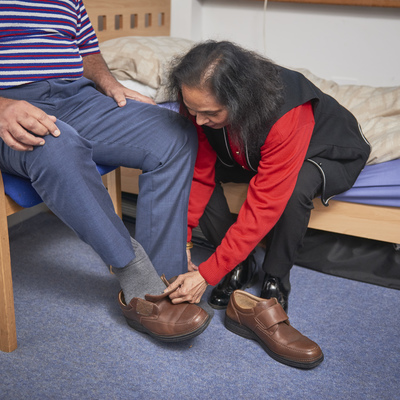4.3.2 Other types of pain
Dyskinesia may occur during ‘off’ periods in the end stage of Parkinson’s if the person has been on long-term levodopa therapy.
This can be managed with reduction of the levodopa dose, but this alone may cause worsening of parkinsonism symptoms and increasing frequency of ‘off’ periods, so a monoamine oxidase type B (MAO-B) or catechol-O-methyltransferase (COMT) inhibitor may be added if there are no contraindications for their use. If contraindicated, memantine has been helpful in reducing dyskinesia (Varanese et al, 2010).
If a person with Parkinson's has developed dyskinesia and/or motor fluctuations, including medicines 'wearing off', seek advice from a healthcare professional with specialist expertise in Parkinson's before modifying therapy.
Offer a choice of dopamine agonists, MAO-B inhibitors or COMT inhibitors as an adjunct to levodopa for people with Parkinson's who have developed dyskinesia or motor fluctuations despite optimal levodopa therapy, after discussing:
- the person's individual clinical circumstances, eg their Parkinson's symptoms, comorbidities and risks from polypharmacy
- the person's individual lifestyle circumstances, preferences, needs and goals
the potential benefits and harms of the different drug classes.
If dyskinesia is not adequately managed by modifying existing therapy, consider amantadine.
Neuropathic pain is common in Parkinson’s, indicated by a description of sensory symptoms such as numbness or paresthesia and with a burning or radiating pain.
Neuropathic pain is treated with anticonvulsant agents, such as gabapentin and pregabalin, and antidepressants, such as amitriptyline or duloxetine.
In the dying phase of care the individual will most likely not be able to report pain directly, but monitoring the non-verbal indices will guide the family and health professional of the need for analgesia.
Rigidity/stiffness in advanced Parkinson’s may be the result of a variable response to dopaminergic medication, and increased intolerance due to associated neuropsychiatric complications.
Rigidity will usually affect the limbs causing associated pain.
It is difficult at this advanced stage to balance treatment for rigidity without increasing or causing agitation, hallucinations or somnolence.
To lessen rigidity, ensure dopaminergic medication is given on time according to the individual’s usual regimen. In addition to their usual regimen, use doses of dispersible levodopa/benserazide (or rotigotine transdermal patches if their swallow is compromised).
If a percutaneous endoscopic gastrostomy (PEG) is already in situ, this would be used to administer medication. If not in place, administer by nasogastric (NG) tube, which would only be considered as a short-term solution.
If a person with Parkinson’s is on an apomorphine pump at the end stage of life, it may be appropriate to maintain the infusion to prevent rigidity and pain. But if the person has suffered weight loss or is experiencing side effects, it may be appropriate to lower the rate as guided by the consultant.
In the dying phase of care there may come a time when it is impossible to administer oral medications and transdermal rotigotine patches are contraindicated due to increased agitation or hallucinations. In these circumstances, the administration of midazolam in a subcutaneous infusion, under the guidance of the specialist palliative care team, may be effective in treating rigidity.
4.3.1 Pain

